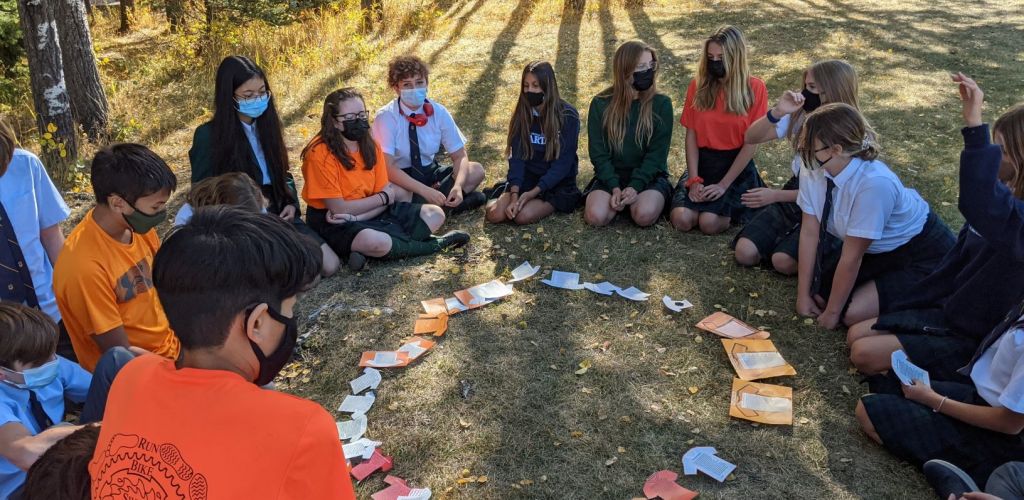
Honouring Truth and Reconciliation in Middle and Senior School
By: Melony O'Neill, Social Studies Learning Leader
As the colours and hues of the STS campus turn to rich, deep oranges and crisp yellows, the month of September begins to wane. September is synonymous with school. Every September, for more than 160 years, thousands of Canada’s Aboriginal children returned to 130 federally funded, church-run Indian Residential Schools, scattered across Canada. In 1894, the Indian Act gave the Canadian government authorization to remove Indigenous children from their families if it was felt that they were not being properly cared for, or educated and place them in government schools. Subsequent amendments in1920 to Canada’s Indian Act further reinforced compulsory attendance at Indian residential schools. Residential Schools were built with one intention; the deliberate assimilation and colonization of First Nation, Inuit, and Metis children. These schools permanently fractured aboriginal children from their families and from their culture. This strategy, by the Canadian federal government, resulted in thousands of Indigenous children losing their identity, culture, family, language, religion, traditions, identity, dignity and tragically, in too many cases, their lives. Over 150,000 Indigenous children between the ages of 4-16 walked through the front doors of Canada’s Residential Schools; many, however, did not walk out.
The Truth and Reconciliation 94 Calls to Action, the ATA Professional practice standards, and the Alberta Leadership Quality Standard, support the teaching of the historical, social, economic, and political implications of Canada’s Residential schools through age-appropriate curricula designed to educate children from Kindergarten to Grade 12.
STS is actively and empathetically exploring, designing, and developing different pedagogical approaches to learning about the legacy of Canada’s Residential Schools and Indigenous ways of knowing and being. STS faculty have been helping students make sense of Canada’s history and are pursuing opportunities to engage in practices that facilitate reconciliation within the school community. Such intentional activities in the Middle and Senior School include:
- Stats Canada analysis of Aboriginal peoples in Canada
- Appropriate use of terminology when speaking of and about Canada’s Aboriginal peoples
- Defining First Nations, Metis, and Inuit peoples
- Critical thinking activities, drawing inferences, and conclusions about Canada’s aboriginal peoples
- Listening to indigenous music videos (Ni’we Jinan Artists) and A Tribe called Red (aka Halluci Nation) to better understand the concept of “activism” in Canada
- Residential school (primary source) photograph analysis, reflection, and discussion
- Poetry analysis, book studies
- Peter B. Ditchburn Library interactive displays, book celebrations, Indigenous student activities, and contests
- Student presentations in assembly addressing Orange Shirt Day (MS) and Reconciliation (SS)
- Thought bubble reflections and Orange Shirt Day reflection writing. Students respond to the inquiry questions of, “Why does truth and history matter?” and “Why does every child matter?”
- Investigating Residential school propaganda video and photographs. Define Propaganda.
- Listening to an animated survivor story by Chief Robert Joseph (Ambassador for Reconciliation Canada) to complete a Google Jamboard reflection
- Exploring and defining the 94 Calls to Action, the UN Rights of the Child, and the UN Rights of Indigenous Peoples
- Understanding the Treaty Seven Land Acknowledgement and its significance
- “We are Treaty People”- What does this mean?
- Looking at Canada’s 11 Numbered Treaties. Map analysis.
- Investigating the story of Treaty 7 to discuss the historical context of treaty signing.
- Exploring Indigenous creation stories of Turtle Island to explore Indigenous Worldview to better understand the impact of colonization.
- Sharing circle discussion on Canada’s first Historic National Day of Truth and Reconciliation.
- Current events analysis- Catholic Priests issue an Apology- exploring differing perspectives in the news, listening to differing opinions and actions made in the name of Reconciliation.
- Analysis of the Survivor’s Flag designed by over thirty Residential School Survivors. Discovering Indigenous survivor worldview inside the newly released Survivor's Flag.
STS students and faculty have been deeply engaged in learning about the history behind Canada’s Residential school legacy. Finding strength in our own learning community to better understand and facilitate Truth and Reconciliation with Indigenous Peoples has provided students and faculty with a deeper understanding of our history and what it means to “reconcile” and heal. We hope that today, September 30th, Canada’s National Day for Truth and Reconciliation, STS students share some of their learning with family members, engage in and view coverage from the Centre for Truth and Reconciliation festivities and celebrations, and take some time for some personal, quiet, reflection. The photographs shared with this story evidence the learning students are experiencing in the month of September at STS.


